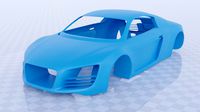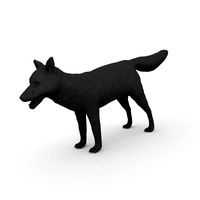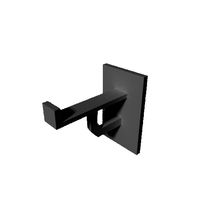3dExport

FAIRY CHIMNEYS-HOODOO 3D MODEL-3D PRINTABLE
by 3dExport
Last crawled date: 1 year, 9 months ago
Hoodoos in Bryce Canyon National Park, Utah*
A Hoodoo (also called a tent rock, fairy chimney, or earth pyramid) is a tall, thin spire of rock formed by erosion. Hoodoos typically consist of relatively soft rock topped by harder, less easily eroded stone that protects each column from the elements. They generally form within sedimentary rock and volcanic rock formations.
Hoodoos range in size from the height of an average human to heights exceeding a 10-story building. Hoodoo shapes are affected by the erosional patterns of alternating hard and softer rock layers. Minerals deposited within different rock types can cause hoodoos to have different colors throughout their height.
The secret of Cappadocia is hidden with the geographical formations dating back to 60 million years. The smooth layers formed by the lava and ashes spewed out from the Mount Erciyes, Mount Hasan and Mount Gulludag has become rocky formations first and than corroded with the rain and wind for million years and finally showed up today’s geographic formations.
According to Herodotus, in the time of the Ionian Revolt (499 BC), the Cappadocians were reported as occupying a region from Mount Taurus to the vicinity of the Euxine (Black Sea). Cappadocia, in this sense, was bounded in the south by the chain of the Taurus Mountains that separate it from Cilicia, to the east by the upper Euphrates, to the north by Pontus, and to the west by Lycaonia and eastern Galatia.
The name, traditionally used in Christian sources throughout history, continues in use as an international tourism concept to define a region of exceptional natural wonders, in particular characterized by fairy chimneys and a unique historical and cultural heritage.
Hoodoos typically form in areas where a thick layer of a relatively soft rock, such as mudstone, poorly cemented sandstone, or tuff (consolidated volcanic ash), is covered by a thin layer of hard rock, such as well-cemented sandstone, limestone, or basalt. In glaciated mountainous valleys the soft eroded material may be glacial till with the protective capstones being large boulders in the till. Over time, cracks in the resistant layer allow the much softer rock beneath to be eroded and washed away. Hoodoos form where a small cap of the resistant layer remains, and protects a cone of the underlying softer layer from erosion. The heavy cap pressing downward gives the pedestal of the hoodoo its strength to resist erosion.With time, erosion of the soft layer causes the cap to be undercut, eventually falling off, and the remaining cone is then quickly eroded.
Polys:
Verts:
Tris:
Edges:
We Lowered The Price.
--------------------------------------------------------------------------------------------
File Formats.
---------------------------------------------------------------------------------------------
A Hoodoo (also called a tent rock, fairy chimney, or earth pyramid) is a tall, thin spire of rock formed by erosion. Hoodoos typically consist of relatively soft rock topped by harder, less easily eroded stone that protects each column from the elements. They generally form within sedimentary rock and volcanic rock formations.
Hoodoos range in size from the height of an average human to heights exceeding a 10-story building. Hoodoo shapes are affected by the erosional patterns of alternating hard and softer rock layers. Minerals deposited within different rock types can cause hoodoos to have different colors throughout their height.
The secret of Cappadocia is hidden with the geographical formations dating back to 60 million years. The smooth layers formed by the lava and ashes spewed out from the Mount Erciyes, Mount Hasan and Mount Gulludag has become rocky formations first and than corroded with the rain and wind for million years and finally showed up today’s geographic formations.
According to Herodotus, in the time of the Ionian Revolt (499 BC), the Cappadocians were reported as occupying a region from Mount Taurus to the vicinity of the Euxine (Black Sea). Cappadocia, in this sense, was bounded in the south by the chain of the Taurus Mountains that separate it from Cilicia, to the east by the upper Euphrates, to the north by Pontus, and to the west by Lycaonia and eastern Galatia.
The name, traditionally used in Christian sources throughout history, continues in use as an international tourism concept to define a region of exceptional natural wonders, in particular characterized by fairy chimneys and a unique historical and cultural heritage.
Hoodoos typically form in areas where a thick layer of a relatively soft rock, such as mudstone, poorly cemented sandstone, or tuff (consolidated volcanic ash), is covered by a thin layer of hard rock, such as well-cemented sandstone, limestone, or basalt. In glaciated mountainous valleys the soft eroded material may be glacial till with the protective capstones being large boulders in the till. Over time, cracks in the resistant layer allow the much softer rock beneath to be eroded and washed away. Hoodoos form where a small cap of the resistant layer remains, and protects a cone of the underlying softer layer from erosion. The heavy cap pressing downward gives the pedestal of the hoodoo its strength to resist erosion.With time, erosion of the soft layer causes the cap to be undercut, eventually falling off, and the remaining cone is then quickly eroded.
Polys:
Verts:
Tris:
Edges:
We Lowered The Price.
--------------------------------------------------------------------------------------------
File Formats.
---------------------------------------------------------------------------------------------
Similar models
cg_trader
$10

FAIRY CHIMNEYS-HOODOO 3D MODEL-3D PRINTABLE-2022
...ure hoodoo hood 3dsmax architectural year 2022 luxury collection printable 3dprint new scifi hair sale decoration astronaut hobby
cg_trader
$13

Cappadocia Fairy Chimneys 2
... chimneys 2
cg trader
3d model cappadocia fairy chimneys 2 cappadocia, available in max, obj, fbx, ready for 3d animation and ot
cg_trader
$14

Cappadocia Fairy Chimneys 1
...imneys 1
cg trader
3d model cappadocia fairy chimneys 1 cappadocia, formats include max, obj, fbx, ready for 3d animation and ot
cg_trader
free

Cappadocia
...f years of civilization. capadokia goreme cappadocia nevsehir fairy chimneys turkey characteristic harvester urgup exterior other
thingiverse
free

peri bacaları kalemlik, cappadocia by ezers
...r museum , a world heritage site, has the best collection of chapels and living quarters, most dating to around the 11th century.
cg_trader
$23

Cappadocia Fairy Chimneys
...y chimneys
cg trader
cappadocia fairy chimneys 3d asset , formats include max, bip, obj, mtl, fbx, ready for 3d animation and ot
cg_trader
$13

Cappadocia Fairy Chimneys 3
... chimneys 3
cg trader
3d asset cappadocia fairy chimneys 3 , available in max, obj, 3ds, fbx, c4d, ready for 3d animation and ot
cg_trader
$14

Cappadocia Fairy Chimneys 4
...neys 4
cg trader
3d model cappadocia fairy chimneys 4 , available formats max, obj, 3ds, fbx, c4d, ready for 3d animation and ot
thingiverse
free

peri bacaları,cappadocia by ezers
...r museum , a world heritage site, has the best collection of chapels and living quarters, most dating to around the 11th century.
cg_trader
$12

Fairy chimneys
...ude any backgrounds, lights, or cameras used in preview images.
several exchange formats including .blend, .obj, .fbx, .dae, .stl
Hoodoo
3dfindit
free

HooDoo 200.53 Designed for Focus
...hoodoo 200.53 designed for focus
3dfind.it
catalog: 3form
thingiverse
free

Tevo Tarantula glass bed bracket tensioner by Hoodoo
...design by this one to have a mechanism to hold tight your glass.
simply insert two nuts in the slots and two screws in the holes.
thingiverse
free

Glass tensioner and braket by jcmunozac
...a remix of two things : the one by hoodoo scaling to fit the design from jeanhame. thaks to...
thingiverse
free

Bryce Canyon Section by thesecapsi
...utah and is known for the brightly colored sandstone hoodoo that form along the cliff edges. unfortunately, most of...
sketchfab
$16

Bryce Canyon, Utah
...in 2012. “there is no place like bryce canyon. hoodoo (odd-shaped pillars of rock left standing from the forces...
cg_trader
$10

FAIRY CHIMNEYS-HOODOO 3D MODEL-3D PRINTABLE-2022
...ure hoodoo hood 3dsmax architectural year 2022 luxury collection printable 3dprint new scifi hair sale decoration astronaut hobby
cg_trader
$16

Ouija board
...number warlock fortune teller evocation halloween fear demon horror hoodoo entertainment party spirit pumpkin magician sports toy halloween...
cg_trader
$12

Fairy chimneys
...of some fairy chimneys, rock formations also known as hoodoo which can be found in particular areas of the...
cg_trader
$7

Bryce Canyon
...plateau. bryce is distinctive due to geological structures called hoodoo, formed by frost weathering and stream erosion of the...
Fairy
3ddd
$1

FAIRY
...и врезной светильники. материал: прозрачное стекло, хром. все карты процедурные + ies. размеры соответствуют техническим чертежам
3d_export
$7

fairy sister
...fairy sister
3dexport
fairy sister
turbosquid
$29

fairy
...yalty free 3d model fairy for download as blend, 3ds, and fbx on turbosquid: 3d models for games, architecture, videos. (1161483)
turbosquid
$49

Fairy
... available on turbo squid, the world's leading provider of digital 3d models for visualization, films, television, and games.
turbosquid
free

Fairy
... available on turbo squid, the world's leading provider of digital 3d models for visualization, films, television, and games.
3d_export
$25

Fairy
...fairy
3dexport
simple rendering of the scene file
3d_export
$25

Fairy
...fairy
3dexport
simple rendering of the scene file
3ddd
$1

Leucos Fairy
...leucos fairy
3ddd
leucos
светильник потолочный
итальянской фабрики leucos,
модель fairy.
3d_export
free

fairy tower
...fairy tower
3dexport
just a free 3d model of a fairy tower. free to use for all users in any projects.
3d_export
$20

Fairy 3D Model
...fairy 3d model
3dexport
fairy model blender head textured texture
fairy 3d model ravianu2012 57043 3dexport
Chimneys
archibase_planet
free

Chimney
...e planet
chimney ventpipe industrial chimney flue
chimney factory n210814 - 3d model (*.gsm+*.3ds) for exterior 3d visualization.
archibase_planet
free

Chimney
...anet
chimney ventpipe industrial chimney flue
chimney metal n181215 - 3d model (*.gsm+*.3ds+*.max) for exterior 3d visualization.
archibase_planet
free

Chimney
...chimney
archibase planet
chimney funnel smoke-stack
chimney 150x1000 - 3d model for interior 3d visualization.
archibase_planet
free

Chimney
...chimney
archibase planet
flue chimney
chimney n190410 - 3d model (*.gsm+*.3ds) for exterior 3d visualization.
archibase_planet
free

Metal chimney
...archibase planet
metal chimney chimney funnel
metal chimney n061214 - 3d model (*.gsm+*.3ds+*.max) for exterior 3d visualization.
turbosquid
$5

Chimneys
...urbosquid
royalty free 3d model chimneys for download as max on turbosquid: 3d models for games, architecture, videos. (1353590)
3d_ocean
$8

Chimney
...me application/game engine.it is optimzed, the triangles number is 762 and it has a 1024×1024 texture size. it was modeled in ...
turbosquid
$5

Chimney
...yalty free 3d model chimney for download as obj, c4d, and fbx on turbosquid: 3d models for games, architecture, videos. (1480701)
turbosquid
$20

chimney
... available on turbo squid, the world's leading provider of digital 3d models for visualization, films, television, and games.
turbosquid
$18

Chimney
... available on turbo squid, the world's leading provider of digital 3d models for visualization, films, television, and games.
Printable
turbosquid
$5

printable giraffe
...uid
royalty free 3d model printable giraffe for download as on turbosquid: 3d models for games, architecture, videos. (1504825)
turbosquid
$49

Longhorn Printable
...
royalty free 3d model longhorn printable for download as stl on turbosquid: 3d models for games, architecture, videos. (1712930)
3d_export
$2

printable audi car
...printable audi car
3dexport
printable audi car
turbosquid
$40

Fox printable
...lty free 3d model fox printable for download as blend and stl on turbosquid: 3d models for games, architecture, videos. (1507558)
turbosquid
$23

Printable Statue
...ty free 3d model printable statue for download as obj and stl on turbosquid: 3d models for games, architecture, videos. (1415137)
turbosquid
$3

Ear Printable
...yalty free 3d model ear printable for download as obj and stl on turbosquid: 3d models for games, architecture, videos. (1671689)
turbosquid
$1

heart printable
...y free 3d model heart printable for download as stl and sldpr on turbosquid: 3d models for games, architecture, videos. (1209566)
turbosquid
$1

Printable Hook
...
royalty free 3d model 3d printable hook for download as stl on turbosquid: 3d models for games, architecture, videos. (1413683)
turbosquid
$30

Printable support
... model 3d printable support for download as max, 3ds, and stl on turbosquid: 3d models for games, architecture, videos. (1689342)
turbosquid
$24

Printable Dolphin
...el printable dolphin for download as , dae, fbx, obj, and stl on turbosquid: 3d models for games, architecture, videos. (1602353)
